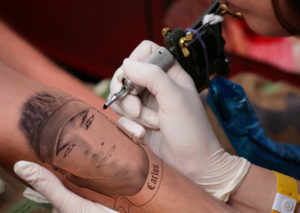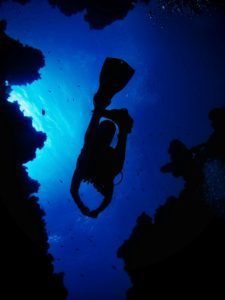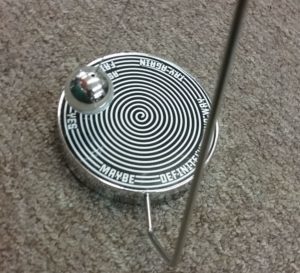Chloe Holiday's Blog, page 16
January 15, 2021
Tattoos: Yea or Nay? And a free story 1/15 & 16!

Sarah Ann? She’d do this in a heartbeat!
Tattoo comes from the Samoan word tatau, “to strike,” which refers to the repetitive punctures needed to allow pigments to penetrate the skin. Tattooing is an ancient art form: Egyptian mummies dating back to 3351 B.C. sported tattoos, and Ötzi, “The Iceman,” found frozen in the Alps, had 61 tattoos, mainly linear ones on his legs. Tattoos were most widely practiced by ancient Austronesians, using thorns or shards of obsidian, bone or oyster shells. Modern machines, in contrast, have single-use needles that are driven into the skin at 150 times a second.
European awareness of tattooing was raised by the sordid kidnapping of an Inuit mother and child by French sailors in 1556. The pair were displayed in taverns, probably contributing to future acquisition of tattooed people. The most famous was “Jeoly, the Tattooed Prince,” who was a slave bought in the Philippines with his mother in 1590. His intricate tattoos caused a sensation, but he died of smallpox three months later.
Captain Cook’s voyages to the South Pacific in the late 18th century rekindled interest in tattoos. His expedition botanist got a tattoo, and a French Polynesian man with tattoos was also presented at court, which precipitated an upswing in tattoos among the aristocracy as a status symbol, since artfully done tats were expensive, as opposed to the crude marking of criminals.
The first professional tattoo artist in the U.S. was a German immigrant, who traveled from camp to camp, inking Union and Confederate soldiers alike. This helped start the tradition of military members getting tattoos. For others, the rarity of professional artists meant getting a tattoo was an expensive undertaking, so it became popular among upper-class fashionable adults after the Civil War. Once the electric tattoo machine was invented and the financial barrier was removed, tattoos lost their appeal as status symbols, and instead developed the reputation of being associated with criminals and rebels, and to this day, many workplaces require that tattoos be covered.
Current generations view tattoos as a form of self-expression, which is removing the stigma, as well as any Bad Boy symbolism. In 2008, a U.S. survey found that 14% of adults had tattoos, though it was 32% in the 25-29 age group.
Tats can be accidental or traumatic, when flakes of ground metal are embedded into the skin in industrial work, asphalt in a wound, or a pencil or pen jabbed into skin.
Tattoos have been used in identification of criminals, deserters, and runaway slaves as far back as the Roman Empire. In Chinese and Japanese society, the association with criminals made tattoos taboo. Prisoners were infamously marked in Nazi concentration camps, and gang members use tattoos as a form of identity. American sailors used to carry “Protection Papers,” which were meant to prevent their being pressed into service if captured by another nation. These gave a general description of a sailor, and to be more specific, tattoos were described, leading many sailors to get inked as one more measure to prove identity. These papers also served to prove status as freemen, so Black sailors often chose tattoos to help ensure they could not be captured and enslaved.
Medical tattoos include radiation tattoos, which are simply tiny dots to indicate the edges of radiation fields. Some families choose to tattoo family members suffering from dementia with their names, in case they wander away, to help with identification. The Waffen-SS had tattoos indicating their blood type, and since this was presumptive evidence of their Nazi association, after the war, many ex- Waffen-SS members shot themselves through the arm to remove the tattoo. Some modern patients choose to tattoo “Do Not Resuscitate” on their chests, but it’s not recommended, since medical personnel cannot be bound by a tattoo of indeterminate age.
Cosmetic tattoos include permanent eyeliner or lip color, tattoos of areolas in breast reconstruction, and covering of scars or inadvisable earlier tattoos. It’s the excellent camouflage tattoos provide that make me less enthused about tattoos on hunky cover models—all those ripped muscles are obscured by ink.
Though work done without safeguards can spread hepatitis and HIV, tattoos are usually innocuous, though occasionally horrific infections or allergic reactions can result. Red, pink, and purple ink are particularly risky for the latter. Tattoo removal used to be an imperfect affair, leading to smudges, but laser removal is much better, sometimes able to completely remove embedded ink, though not always. In addition, scarring from the initial application may be permanent, though the pigment is gone. So, think twice, and don’t tattoo drunk!
So what do YOU think of tattoos?
Free on Amazon 1/15 & 1/16: Submerged Hopes:

Deaf archaeologist Nerissa’s excavation of an ancient shipwreck uncovers priceless artifacts, stirring the ghosts of her past and the jealousy of colleagues, She falls hard for her interpreter, who’s happy to bed her but can she count on him in the wreck’s spectacular enough to provoke murder?
January 8, 2021
A Reset
 We lost power last night. Here in the Pacific Northwest, that’s always a risk in wintertime, when our tall Douglas firs, buffeted by the wind, lose their grip in the sodden earth and tumble onto power lines.
We lost power last night. Here in the Pacific Northwest, that’s always a risk in wintertime, when our tall Douglas firs, buffeted by the wind, lose their grip in the sodden earth and tumble onto power lines.
It’s certainly a drag in some ways: the loss of central heat, running water, lights, and all we take for granted. Disheartening.
Still, it’s a good opportunity to snuggle up, reconnect with loved ones, and think about what’s important: for me, for my family, for my country, and remember, “This, too, shall pass.”
January 1, 2021
Happy New Year! (and good riddance to 2020!)
A Tough One, Now Past
 My son sent this pic of the sunrise in his new town.
My son sent this pic of the sunrise in his new town.
Covid-19 meant the loss of his job, and the necessity to move out of state for work in his industry, and we miss him terribly.
The pandemic has touched most of us, one way or another: loss of loved ones, of health. Financial worries, loneliness, political division, uncertainty… It’s been one tough year!
Yet I love this picture, because it reminds me that with each new day, hope dawns.
A new day, a new year: one for healing and recovery. My best wishes to all of you, for renewed ties and fortunes, and for the faith to hang in there until this happens!
And in the meantime, escape with some great reading, while you wait!
December 24, 2020
And All Through the House
 The Rat King was stirring…wait, that’s not it! I do have holiday viewing on my mind, though, not only the classics like It’s a Wonderful Life, The Nutcracker, and The Grinch Who Stole Christmas, but movies like Die Hard—does that count as a “classic” if it’s 32 years old?
The Rat King was stirring…wait, that’s not it! I do have holiday viewing on my mind, though, not only the classics like It’s a Wonderful Life, The Nutcracker, and The Grinch Who Stole Christmas, but movies like Die Hard—does that count as a “classic” if it’s 32 years old?
The Nutcracker has always been a love-hate tradition to me: the storyline is disturbing if one examines it closely, and it’s a lot of dancing around, but it was one of my first “grown up” outings as a child, I do enjoy the score, and I’m always struck by the discipline and athleticism of the dancers. This year, I watched it with a more attention, particularly the scenes with the Rat King, because of the appearance of that role in Submerged Hopes.
Though The Nutcracker’s debut was in 1892, the ballet had a tepid reception, and didn’t become popular until the 1960’s. Nowadays, the major ballet companies derive 40% of their revenue from holiday performances of The Nutcracker. Tchaikovsky’s score was better received and included the first use of the celesta or bell-piano, which gives the music-box sound of the “Dance of the Sugar Plum Fairies,” as well as toy instruments. It’s said that he composed the adagio from the Grand pas de deuce in response to a wager, when a friend bet him he could not pull off a melody based on a sequential, one-octave scale.
Love it or hate it, The Nutcracker score is famous enough to appear everywhere, and it’s made homage appearances in the violent Tom and Jerry cartoons, a Barbie movie, and multiple video games.
Best wishes (Christmas, Hannukkah, Solstice, Kwanzaa) of the holiday season to all of you!
December 20, 2020
Surf’s Up!
 I love a good sports romance, but tire of the same old ballplayers, and besides, why is it only the men who are athletic? So to “be the change I want to see in the world,” New Heights features rock climbing for both the hero and heroine, which is integral to the plot, and Submerged Hopes contains scuba diving and surfing.
I love a good sports romance, but tire of the same old ballplayers, and besides, why is it only the men who are athletic? So to “be the change I want to see in the world,” New Heights features rock climbing for both the hero and heroine, which is integral to the plot, and Submerged Hopes contains scuba diving and surfing.
Surfing has ancient origins. Three to five thousand years ago, the Moche people of ancient Peru (Yes, they of sex pot fame!) used tortora sedges to make reed boats which they used to surf the waves. As early as the 4th century, early surfing was done by people in Samoa, Tonga, Tahiti, and other Polynesian cultures. Ancient cultures rode their boats or boards like a horse, or surfed upon their bellies or knees. It was the Hawaiians who invented stand-up surfing, using koa boards that weighed up to a hundred pounds. While there are related sports that harness the wind or use paddles, “surfing” refers to activities which use the energy of the wave for the ride.
Surfing came to California in 1885, brought by three young Hawaiian princes attending boarding school near Santa Cruz. In 1907, a land baron bought up land in Redondo Beach. He hired a Hawaiian to surf there. George Freeth, the “father of modern surfing,” wanted in but had trouble with the huge, heavy solid wood boards. He cut one down, creating the modern longboard, and surfed twice a day, helping to popularize the sport. Later, the Gidget movies and the Beach Boys fueled the surfing craze, which has now grown to be a multi-million-dollar industry. Surfing is slated to become part of the 2021 Olympics. Skateboarding and snowboarding were spawned by surfers.
Like any active sport, surfing can be hazardous. Collisions with rocks, boards, or other surfers can cause injury—this is part of the reason surfers use leashes, to keep their boards close. Drowning is a risk for even experienced surfers, from rip tides, violent collisions, or prolonged submersion in huge waves—the world’s record for wave height is seventy-eight feet! Marine life, from sharks to stingrays to jellyfish, can also injure surfers. Chronic ailments include surfer’s ear (a painful narrowing of the canal as a reaction to repetitive exposure to cold water), surfer’s eye (an overgrowth of tissue on the cornea from prolonged UV exposure), and surfer’s myelopathy (leg paralysis from hyperextension of the back).
The popularity of surfing has led to the construction of artificial reefs and even indoor surfing parks. Surfers can find wave forecasts on various online sites, which use data from NOAA (National Oceanic and Atmospheric Administration)—the same outfit that tracks Santa’s journey.
Just as in rock climbing, there is a culture associated with surfing, and specific lingo, like “shaka,” “hang ten,” and “wipeout.” Some follow the waves, like the surfers in Point Break, just for the love of surfing and the spiritual experience. A small number of surfers are able to make their living from it, like the freesurfers whose corporate sponsors pay them to perform in competitions or appear in videos, doing tricks or risky stunts, like Nick does in Submerged Hopes in an attempt to impress women.
Cowabunga!
December 4, 2020
Camel Riding 101

Camels, uniquely suited to the harsh desert climate, were once called “the ships of the desert,” and my new work in progress, Hard Truths, features a camel-riding scene in the context of an endurance race. So here’s not only Camel Riding 101, but some fascinating facts about camel history, adaptations, and even camel sex!
Camels come in two main flavors, the single-humped dromedary, native to the Middle East, Africa, and South Asia, and the two-hump Bactrian camel, from Central Asia. The smaller camelids in the New World include the llama, guanaco, alpaca, and vicuña. The earliest known camel lived in South Dakota 50 million years ago and was the size of a rabbit. The largest ancestor was nine feet tall and lived in the Arctic circle; today’s dromedaries are just over seven feet tall at the hump, with Bactrian camels being a foot taller—this means you’d better be on your camel-riding game!
To ride a camel, the animal first “sits” with its legs bent beneath it. First, throw your leg over your camel and hold on to the saddle horn in front. “Bayokav” is the command to rise. Camels get up rear legs first, so it’s easy to be dumped out of the saddle when everything tips forward; to counteract this, lean way back as the back legs push off. The front legs come up next, and the camel tilts backward, so the rider should lean forward to keep balance. Look at you, seven feet in the air!
Once your camel’s standing, the “giddy-up” equivalent is “Arrrrr.” A camel’s gait creates a back-and-forth sideways swaying that takes some getting used to. Camels can be steered (sometimes) with reins, but are notoriously stubborn. Camels can run up to 40 mph for bursts, and are capable of sustained speeds of 25 mph. A panicked camel will generally slow again before long, but if a rope halter is used, pulling the neck around to one side may make the camel run in a circle. However, a mating bull is capable of lifting another bull weighing 1300 pounds with his neck, making it seem unlikely that a puny human would be able to exert much pull. Another form of camel bridle involves reins attached to a nose peg. If that is used, pulling on the reins too hard can rip the peg out of the muzzle, and any control is lost.
To slow your camel, say “Shhhhhhh” and then “oooch” for “lie down.”
Your camel-riding skills could come in handy in a modern adventure; there are excursions which provide this in some parts of the world, where the camel is still venerated for racing, for transport, and for its by-products of hair for textiles, dung for fuel, and meat and milk.
The camel is a marvel of engineering, however odd-looking. The long double eyelashes and extra eyelid help shut out sand, and the slitted nostrils not only keep out sand but help prevent water vapor loss from respiration. Camels lose only 1.3 liters of fluid a day, compared to 30 or more liters for other similarly-sized mammals. Many of the other attributes are adaptations to extreme heat: the long legs elevate it away from the hot sand and the thick coat helps protect its skin from the sun. A thick pad called the pedestal over the sternum helps elevate the body off the ground, permitting cooling air to circulate beneath. A counter-current heat exchange (a meshwork of arteries and veins in close approximation) helps cool the blood before it reaches the brain. Additionally, a camel’s blood cells are oval rather than disc-shaped; this allows the blood cells to circulate better in states of dehydration, and also makes them resistant to wide swings in osmotic pressure—if a camel has a chance to tank up on water, it can drink 200 liters of water in three minutes!
The most famous heat adaptation is the hump, but it does not “store water” as a physical entity. Rather, the hump is composed of fat (and thus concentrated in one spot, to avoid the insulating properties of fat, unlike cold-water mammals like whales). So how does a fat hump help with water needs? When the fat is metabolized, water is produced: for every gram of fat used, an equivalent amount of water is released. A human who is dieting hard might notice a similar thing; with rapid weight loss, urination is increased.
Camels have a long military history, including one with the U.S. Army! I’ll be posting more on this later.
The sexual behaviors of camels are as unusual as their other characteristics. During the cold months, the males go into rut or “musth,” becoming irascible and potentially dangerous. To attract females, they fling their hormones around, by bringing their tails beneath them, soaking them with urine, and then whipping them up and down. Hubba, hubba! To amp up the sexiness, they inflate a portion of their soft palate, which dangles out the side of their mouths. This dulla resembles a big, pink scrotum the size of an eggplant. The last step to becoming irresistible is to make bubbling sounds to churn their saliva into a white, drippy froth—ooh, baby! Mating itself involves coercing the female to “sit” with the male behind her. Camels are the only ungulates to mate in a sitting position.
Not exactly sexy? New Heights is free today—that will do the trick instead!
November 28, 2020
Bent Out of Shape
 Since I can’t resist a good pun, I used this phrase as a chapter title in Submerged Hopes for a character with the bends, but though it’s come to mean “angry,” the idiom originally meant intoxicated or “bent” in 1833. Today, let’s talk about “the bends,” or decompression illness (DCI).
Since I can’t resist a good pun, I used this phrase as a chapter title in Submerged Hopes for a character with the bends, but though it’s come to mean “angry,” the idiom originally meant intoxicated or “bent” in 1833. Today, let’s talk about “the bends,” or decompression illness (DCI).
Decompression illness can occur during recreational or commercial diving, ascent from deep mines, at altitude in unpressurized aircraft, and during extravehicular activities in space. It’s also known as Caisson Disease, and was first noted in bridge workers constructing the Eads Bridge in St. Louis, the Brooklyn Bridge, and the Hudson River Tunnel. A caisson is a deep shaft, pressurized to keep water out, used during prolonged underwater work, like building bridges and dams. Recognition that caisson workers were dying ultimately led to the first medical airlock in 1889. It’s suspected that the affliction called taravana, seen in South Pacific pearl divers who may do as many as sixty dives a day with a short surface interval, is a form of DCI.
The early syndrome was called the “bends” if it involved the joints, since pain in the shoulders, knees, elbows, and ankles made the sufferer flex to attempt to relieve the pressure, “chokes” if they exhibited pulmonary symptoms of chest pain, dry cough, and shortness of breath, and “staggers” for neurologic symptoms of weakness or paralysis. Decompression illness is now classified into Type I (no neurologic symptoms) and Type II. Though the treatment is the same, the distinction has implications for recovery and return to eventual diving.
DCI occurs because at pressure, gas dissolves in the bloodstream and permeates the tissues. This is mainly nitrogen if breathing air. Though other gases do this, too, the exchange is faster for some. Thus, helium is sometimes used in dive mixtures (HeliOx). If the pressure relents slowly enough that the gas can be breathed out by the lungs, no injury occurs. However, if there is an abrupt change in pressure, the dissolved gas can suddenly come out of solution, much like when a soda bottle is opened. This forms bubbles in tissues and the bloodstream. The symptoms depend on the location of the bubbles, but the tendency to occur on a solid surface, or tribonucleation, accounts for not only the bubbles on the stems of flowers in a vase, but the frequency of joint symptoms in the bends.
Joint symptoms happen in 70% of cases, and can be excruciating. The physical disruption of cartilage, and the blockage of tiny blood vessels, can lead to eventual joint replacement for dysbaric osteonecrosis. Skin symptoms include itching, mottling, swelling, and formication, the sensation that bugs are crawling over one’s skin. Neurologic symptoms occur in 15% and manifest as numbness, tingling, heightened sensitivity, confusion, amnesia, visual abnormalities, loss of consciousness, and seizures. General symptoms are fatigue and aching. Most symptoms occur within the first eight hours, but a small percentage may take up to forty-eight hours to manifest.
Emergency treatment involves oxygen and fluids (to help dilute out the nitrogen) but the cornerstone is re-compression in a dive chamber or hyperbaric chamber. Early treatment gives an excellent chance of recovery, but the best plan is simple prevention. Fliers use pressurized aircraft or supplemental oxygen. Scuba divers use dive tables or dive computers to make sure their bottom time does not exceed the time needed to “off-gas” the dissolved nitrogen or “de-fizz,” safety stops underwater to allow an extra buffer for gas exchange, plan dives to allow a surface interval to help with off-gassing, and ascend slowly. Divers also avoid diving for twenty-four hours before flying. Sadly, many insurance carriers in the U.S. don’t cover recompression chamber treatment, evading it as a “recreational, avoidable, high risk” activity, so it’s worth it for a new scuba diver to check this.
Barotrauma is a separate malady, related to physical damage of tissue planes because of pressure, though it can occur in conjunction with DCI. This can be pneumothorax from a ruptured lung, arterial embolism when a blown-out lung allows bigger bubbles into the bloodstream, or perforated eardrums. These can be prevented by slow ascents, care to equalize pressures, and avoidance of holding one’s breath.
Altitude sickness, or acute mountain sickness, is an unrelated affliction, caused not by the rapid accumulation of microbubbles, but rather low oxygen related to low pressure as well as alkalosis, a shift in blood pH.
I find this fascinating but my hope is certainly not to deter any would-be scuba divers, and that maybe the descriptions in Submerged Hopes will encourage it. Should you try scuba diving? I’d say, go for it!
November 20, 2020
The Leonids Peak Now!
 Alas, this week it’s been too cloudy to see the Leonid meteor shower at all.
Alas, this week it’s been too cloudy to see the Leonid meteor shower at all.
The Leonids are one of the most famous and reliable meteor showers seen in the Northern Hemisphere. They peak in mid-November and are some of the fastest meteors seen. The Leonids are famous for their fireballs, which are larger, longer-lasting meteors, and their earthgrazers, which occur low to the horizon, with a long and colorful tail.
Meteors are caused from cosmic debris streaming from the tail of a comet; as the comet passes near the sun, some of its ice evaporates, creating a “dust trail” of sublimated fragments. The dust trail is affected by the Earth’s gravity and that of other planets. Most meteors are smaller than a grain of sand and burn up over fifty miles from the earth’s surface, although some survive their scorching atmospheric entry and impact the ground.
Meteors are named not after the parent comet (the Tempel-Tuttle in this case) but rather the nearest constellation or bright star with a Greek or Roman letter. Thus, the Perseids are named after the constellation Perseus, he who beheaded the Gorgon Medusa, and vanquished the sea serpent to save the Princess Andromeda, and the Leonids after the constellation Leo, the lion.
A meteor shower may contain up to a thousand meteors an hour, but a meteor storm may peak at over two hundred thousand meteors an hour! A storm is caused by a young meteor stream, with the mass still concentrated near the parent’s orbit. The Leonid meteor shower peaks on November 17, but every thirty-three years, the Leonids exhibit a meteor storm. The last one was in 2002, but during the shower of ’66, they were said to fall like rain—in 1833, there were over one hundred thousand meteors an hour, enough that Abraham Lincoln remarked on the event years later, and the Lakota nation reset their calendar. A meteor shower kicks up enough dust from impacts on the Moon that its “sodium tail” is visibly altered. Mark your calendars for 2035!
The Leonids are featured in media in the novel Blood Meridian by Cormac McCarthy, William Faulkner’s short story, “The Bear,” and T.S. Eliot’s poem, “East Coker,” as well as episodes of The Big Bang Theory and The Brokenwood Mysteries. They are referred to as “the Litleonids” in the video game Pokémon Omega Ruby and Alpha Sapphire.
I’m bummed to miss the celestial fireworks, but at least the cloudy skies are good for my writing schedule! And as I work on the soon-to-be renamed Mistress of None, I find myself thinking “just one more” about The Helios Series, thanks to the pleas of a fan who wants Cynthia (New Heights, Submerged Hopes) to have her own story.
November 13, 2020
Greek Fire: Ancient Naval Warfare
 In Submerged Hopes, the hero makes a passing comment regarding learning about ancient naval warfare techniques in the Naval Academy. Here’s what I learned in my research!
In Submerged Hopes, the hero makes a passing comment regarding learning about ancient naval warfare techniques in the Naval Academy. Here’s what I learned in my research!
Sea power was critical in antiquity for the movement of troops, ammunition, food, and fodder, and that alone helped cement the authority of the ancient empires, like the Egyptians, the Phoenicians, Athens, Carthage, and Rome, as well as more recent contenders like Venice, the Vikings, and Great Britain. Over time, naval activities evolved into a combat role, instead of mere transport.
The earliest datable sea battle was in 1210 B.C., when a Hittite king defeated the fleet from Cyprus, though scenes from an Egyptian temple depict a naval ambush and archers, both ashore and from ships, to defeat the “Sea Peoples,” a confederation of enemy nations. Assyrian reliefs show Phoenician warships with double oars, fighting men on a platform, and a ram below the waterline to breach hulls.
The oracle of Delphi’s prediction of “wooden walls” to protect Athens referred to her wooden ships, which were funded by the profits from her silver mines, and her naval supremacy was unparalleled at the time. In 480 B.C. at the Battle of Salamis, the Athenians were able to trap the Persian army in a narrow channel. The enemy sustained losses of 200 ships, to forty of the Athenian fleet. The story is the subject of “The Persians,” the world’s oldest surviving play, which was written only a few years after the battle.
Mobility depended on oarsmen, but to have enough room for many men led to longer and longer ships, which were unwieldy and heavy—no small thing since these softwood ships became waterlogged if left in the ocean. It was typical to ground the fleet at night, with as few as 140 men carrying a ship ashore. This did make them vulnerable to attack, and ancient references to “burning a fleet” generally meant beached ships caught unawares.
To solve the problem of power and maneuverability, designs incorporated double lines of rowers, some deep in the hold and another row on the deck; these ships were called biremes. Over time, triremes became standard, with two rows on men working in the dark, with chants to keep time. These ships could go six knots and cover about fifty miles in an eight-hour day. Later, during the Roman Empire, the massive quinqueremes had five levels of rowers.
The main method of attack was ramming with a bronze-tipped beam below the waterline, though each ship did have ten or twenty marines for archery or hand-to-hand combat. Evasive maneuvers were the first level of defense, and crews were trained to rush to the other side of the boat if a hole was punched in the hull, to try to keep the breach above the waterline and stay afloat. Some ships had a brass band as protection, but this added weight. Thus, Zakynthos Island, which was famous for its waterproofing pitch, was of strategic military importance, and changed hands many times.
Overtime, further refinements in war included a hinged drawbridge called a raven, which caused a spike on the bottom to pierce hulls and also helped board, a dolphin, a huge lead weight with a pointed bottom, which could be dropped from a yardarm through the hull, and “Greek fire.” The only known example of a war dolphin came from the Antikythera Shipwreck northwest of Crete (check out the website if you missed it!).
Greek fire was essentially a flamethrower, either ship-mounted, or held by a single man, used by the Byzantine navy. The exact recipe was a closely-held secret, as was the workings of the machinery, called a siphon, so much that workers were trained on one section of the mechanism and kept ignorant of the rest. The flames spewed out to coat an enemy ship, and floated atop the water. It must have been terrifying; the machines were said to rumble and roar, and the spigot tip was often fashioned into the face of a beast. Greek fire could also be lobbed via flaming pots, and probably was the inspiration for the “wildfire” in Game of Thrones.
The composition has been lost in antiquity but it appears to have contained naphtha (a crude petroleum) and quicklime. The fragments of instructions caution the makers to avoid direct sunshine because of the tendency of the compound to spontaneously combust.
Constantinople was saved by Greek fire during the first and second Arab sieges in 672, and the technology was ascribed to a divine gift. Eventually, the Arabs captured a fireship containing siphons and the compound itself, but were never able to replicate it. Regardless of its offensive capabilities, Greek fire was limited by prevailing winds and its relatively short range. Over time, the Arabs learned simply to stay out of reach, and to cover their ships with vinegar-soaked felt. The Arab Empire became dominant in the Mediterranean from the 7th-13th centuries, during the Islamic Golden Age, and it was during this time that the torpedo was invented in Syria.
Refinements in gunpowder in the late 16th century brought the extensive use of heavy cannons, and the invention of steam power permitted huge ships with heavier weaponry and armor, ushering in the modern age.
Lastly, there is a Greek Fire cocktail recipe, which combines brandy and ouzo. Alas, though it seems it should be served flaming, that’s not the case, but it does burn! Yiamas!
November 6, 2020
Reading the Tea Leaves
 Divination: Tea Leaves, Entrails, & Hallucinogens, oh, my!
Divination: Tea Leaves, Entrails, & Hallucinogens, oh, my!
Here’s something fun I learned from writing Submerged Hopes, which contains a scene in which the hero offers to tell the fortune of the heroine, from reading the dregs of her coffee cup. Nick, who knows enough about the culture to seize the chance, tries his hand at tasseography, predicting she’ll fall for a man who just happens to look a lot like him.
The practice of divination dates from prehistoric times. In Greece, there were two broad classes of practitioners: the officially-sanctioned oracles, who were installed in a given location, who were supported by a priesthood and sacrifices by those who made pilgrimages to seek their advice, versus independent seers, who were be hired by an individual ruler or military campaign. Though divination was denounced by later religions and skeptics, it served as a way to give advice to state and military leaders, and as propaganda, to bolster confidence and support from the public as well as the superstitious soldiers under a general’s command.
Unsurprisingly, the hired seers were less likely to contradict a leader’s chosen route—or suggest they sacrifice their own child!—instead, offering prophecies that supported the leader’s decisions, though the prophet’s words were often ambiguous. Over 500 prophecies of the Pythi, the most famous oracles who served Apollo at Delphi, have survived the centuries.
There were several methods through which the prophecies were obtained. The two main categories were enthusiasm, or possession, in which the gods spoke through the ravings or dreams of the oracle (after a suitable sacrifice), or extispicy, the examination of the entrails (the meat being used for the priesthood later). The priestess at Delphi chewed bay (laurel) leaves or dipped their nails in laurel oil, drank water from a sacred stream, and sat on a tripod over a chasm which emitted toxic vapors, while another stood ready to take down her mind-altered speech. Even today, a common Greek idiom for “I have no idea” is, “Shall I smell my fingers?” which refers to the scent of the laurel oil which helped induce the prophetic trances so long ago.
Other forms of divination included cleromancy (the use of dice or lots, including astragalomancy, which involved carved sheep knucklebones), hydromancy (the use of water), pyromancy (the use of fire), thriai (the use of pebbles), and stikhomanteia (drawing slips out of a hat or opening a book to a random passage). Thus, it turns out I used stikhomanteia to choose the topic for one of my novels, when I had too many ideas I loved, all clamoring for attention!
On to tasseography! Nick used it with Greek coffee, but tea leaves or even wine dregs will work. To do a proper Greek coffee reading, one must obtain strong brew with thick dregs, preferably made in a long-handled pot called a briki. The fortune-seeker should enjoy the coffee while thinking about their questions or worries. When only the dregs remain, the fortune-teller takes the cup, and, holding the top tilted away to prevent splashing, rotates the cup three times clockwise to spread the sludge, dumps the excess out on the side with the handle, and sets it upside down on a napkin to drain for a few minutes.
The cup is then examined for shapes—animals, symbols, letters, landmarks—with an open mind. The bottom of the cup represents the past, the middle indicates the present, and the top portion shows what is to come. As in days of old, the predictions are open-ended and vague, which allows wiggle room as well as hope.
The surviving Delphic predictions are fascinating for anyone who loves history; I’ve included a link below.



